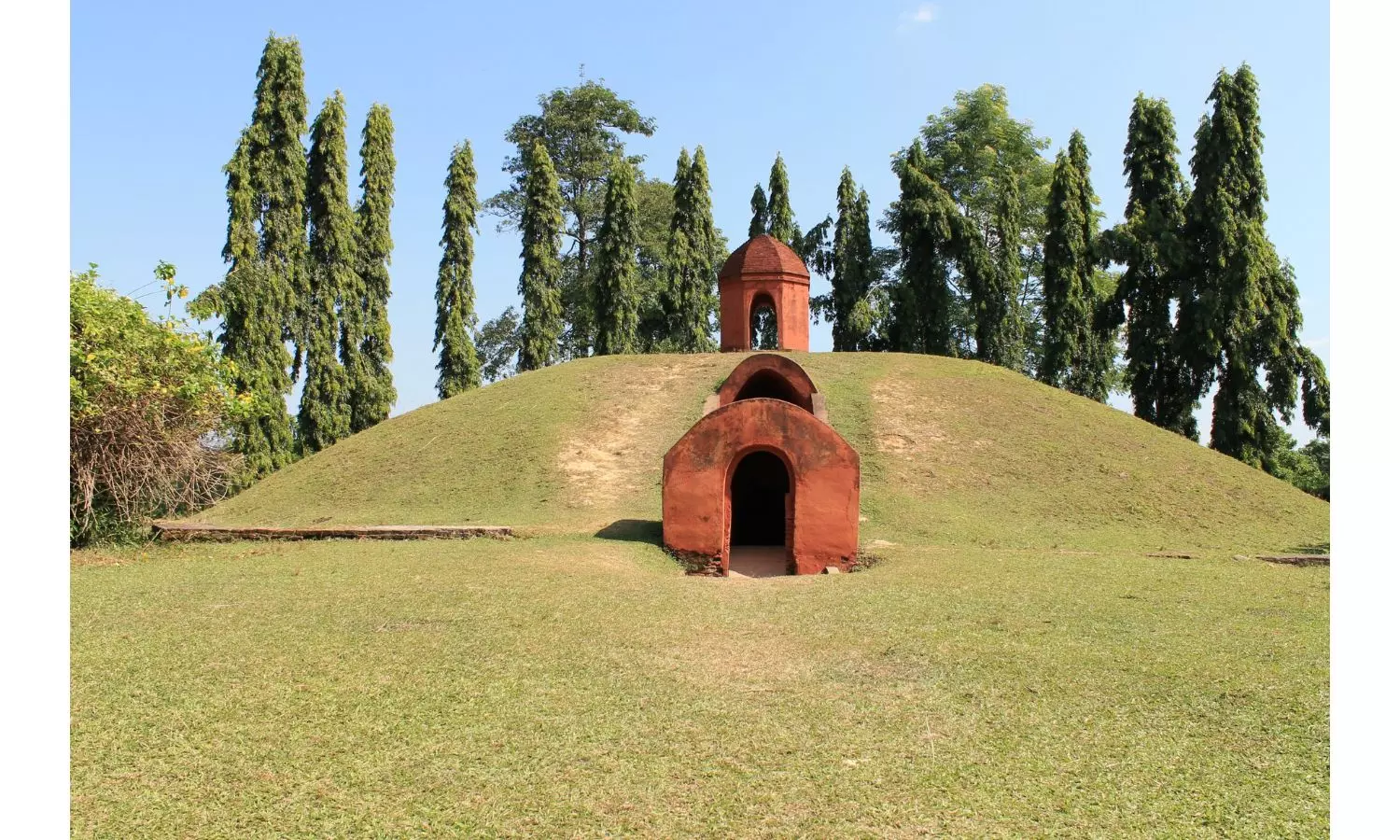Ahom 'Moidam' Recommended For Inclusion In UNESCO World Heritage List

Ahom 'Moidam' Recommended For Inclusion In UNESCO World Heritage List (Image Source: X)
Guwahati: Ahom era 'Moidams', the resting place of royal families, in Assam's Charaideo district have been recommended for inclusion in the UNESCO World Heritage List by its international advisory body ICOMOS.
The International Council on Monuments and Sites (ICOMOS) has prepared a report 'Evaluations of Nominations of Cultural and Mixed Properties' for the 46th ordinary session of the World Heritage Committee, to be held in New Delhi on July 21-31.
The report, which PTI has accessed, evaluated a total of 36 nominations, including 19 new ones, received from across the globe and the Ahom Moidam was the only applicant from India.
"ICOMOS recommends that Moidams -- the Mound-Burial System of the Ahom Dynasty, India, be inscribed on the World Heritage List on the basis of criteria (iii) and (iv)," it said.
With this recommendation, the first-time applicant Moidams is just one step short of formally entering the World Heritage List by the United Nations Educational, Scientific and Cultural Organization (UNESCO). These were first included in the Tentative List in April 2014.
France-based ICOMOS, also an advisory body to UNESCO for cultural heritage, is an international non-governmental organisation that is comprised of professionals, experts, representatives from local authorities, companies, and heritage organisations, and is dedicated to the conservation and enhancement of the architectural and landscape heritage throughout the world.
Inclusion of Moidams in the World Heritage List was sought by the Indian government on the basis of Cultural Criteria (iii), (iv), and (v). The nominated property has an area of 95.02 hectares and a buffer zone of 754.511 hectares.
Criterion (iii) bears a unique or at least exceptional testimony to a cultural tradition or to a civilization that is living or which has disappeared and criterion (iv) is for an outstanding example of a type of building, architectural or technological ensemble, or landscape which illustrates significant stages in human history.
The Criterion (v), which ICOMOS rejected, is for an outstanding example of a traditional human settlement, land use, or sea use which is representative of a culture or human interaction with the environment, especially when it has become vulnerable under the impact of irreversible change.
The report stated that 90 Moidams are found within the Charaideo necropolis, situated on elevated land. These were created by building an earth mound over a hollow vault constructed of brick, stone, or earth, and topped by a shrine at the centre of an octagonal wall.
The Moidams situated in Charaideo are the burial grounds of Ahom kings and queens. These are comparable to the pyramids of Egypt and substances of wonder seen through the brilliant architecture and expertise of the artsmen and masons of Assam of the medieval era.
"ICOMOS considers that the nominated property demonstrates 600 years of Tai-Ahom traditions at Charaideo. ICOMOS considers that the nominated property is an exceptional example of a Tai-Ahom necropolis that represents tangibly their funerary traditions and associated cosmologies," the report said.
It highlighted that the conditions of 'integrity and authenticity' of the property have been met. There are no inhabitants within the nominated property and approximately 4,017 inhabitants live in the buffer zone.
"The nominated property is well-maintained and there are no adverse effects of development. The moidams are mostly undisturbed. Five of the moidams have been subject to archaeological excavations, involving differing levels of intervention," it added.
Based on the information provided by the state and the observations of the ICOMOS technical evaluation mission, the main factors affecting the property are heavy rainfall, soil erosion, and vegetation growth, the report said.
"Works are also in place to prevent soil erosion and the growth of trees on the mounds," it added.
ICOMOS noted that the area has a high concentration of Moidams associated with Tai-Ahoms. There are other associated elements located in the buffer zone such as Moidams and sites related to the funerary system.
"The buffer zone has been extensively surveyed and officially demarcated and all archaeological sites are marked," it said, adding an ICOMOS technical evaluation mission visited the nominated property from October 5 to 11 last year.
The site is jointly managed by two separate entities -- Archaeological Survey of India (ASI) and the Assam Government's Directorate of Archaeology (DoA). All matters affecting the prohibited and regulated zones are approved by the joint management.
"ICOMOS considers that the legal protection is adequate. The joint management arrangements require ongoing and effective coordination. Further development of the management system to include a sustainable tourism strategy and interpretation plan is needed," the 321-page document stated.
Considering the present documentation, conservation, and monitoring as adequate by the ASI and DoA, ICOMOS stated that there is an ongoing program of recording details and the state provided the inventory of all 319 known moidams in the Brahmaputra Valley in the additional information dossier in February 2024.
The Tai-Ahoms migrated to present-day Assam in the 13th century and selected Charaideo as their first capital and location for the royal necropolis. For 600 years till the 19th century, they created moidams that work with the natural features of hills, forests, and water, creating a sacred geography by accentuating the natural topography.
( Source : PTI )
Next Story

